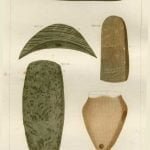
The pointed mace, found in the early North American graves and barrows, is uniformly of a semi-lunar form. It appears to have been the Cassetete or head-breaker, such as we can only ascribe to a very rude state of society. It was employed by warriors prior to the introduction of the agakwut and tomahawk. All the specimens examined have an orifice in the center of the curve for the insertion of a handle. Its object was to penetrate, by its sharp points, the skull of the adversary. This was not done by cutting, as with the agakwut or mace, but by perforating the cranium by its own gravity, and the superadded force of the warrior. In an attack, it must have been a powerful weapon.
A specimen (Figure 1, Plate 11) obtained through the intervention of F. Follett, Esq., from a small mound on the banks of the Tonawanda, near Batavia, New York, is of the following dimensions. Length, eight inches: breadth, one and a half inches: thickness, about one and a quarter inches.
The material is a neutral-colored siliceous slate, exquisitely worked and polished. Its weight is half a pound.
Another specimen (Figure 2, Plate 11) from Oakland County, Michigan, has both the lunar points slightly broken off, yet it weighs six and a half ounces. It is of the same material, but striped. It is, in all respects, a stouter instrument.
The use of this instrument, as well as the antique spear or shemagun, mark an era prior to the discovery.
